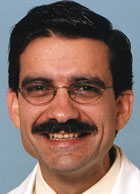School of Medicine researchers are seeking participants for the AIR2 (Asthma Interventional Research) international, multi-center clinical trial, which explores whether a new asthma treatment improves asthma care.
The trial, the first test of the procedure in the United States, focuses on a procedure called bronchial thermoplasty to treat asthma. Early patient data from trials outside the United States suggest it may hold promise for moderate and severe asthmatic patients.

“This is an exciting trial because for the first time ever in the United States, we are looking at a non-pharmacological treatment for asthma,” said Mario Castro, M.D., principal investigator of the study at the School of Medicine and associate professor of medicine. “Currently, if you suffer from asthma, medication is the only treatment available to you for relief, so there is the potential this clinical trial may change the way we care for millions of asthma sufferers.”
Asthma is one of the most common and costly diseases in the world. It affects more than 20 million people in the United States alone, with an estimated 2 million emergency room visits and 5,000 deaths per year. The prevalence of asthma is on the rise, and there is no cure.
Asthma involves greater than normal responsiveness of airways in the lungs to a variety of stimuli. This increased responsiveness can take the form of swelling of the airway wall, excess mucus production that can clog the airways, and significant narrowing of the airways when tiny muscles in the airway wall — called airway smooth muscles — contract.
The researchers point out that there is no expectation that this procedure will cure asthma. However, it is hoped that it could be useful in reducing the severity and frequency of asthma symptoms and improving quality of life for patients with asthma. Thus, bronchial thermoplasty may become one of the treatments available for the management of asthma.
During bronchial thermoplasty, physicians use a flexible bronchoscope inserted through the nose or the mouth to deliver thermal energy to the airway walls. The controlled heat is designed to reduce the amount of smooth muscle in the airway wall, thereby reducing the ability of the airway walls to contract, narrow and spasm in response to irritation, infection or inflammation.
The procedure has been used successfully in 16 patients with asthma who were enrolled in a safety trial at two asthma centers in Canada. Two years following their last treatment, the patients on average showed less airway narrowing during a test using a drug that causes contraction of airway smooth muscle.
During the clinical trial, physicians will treat one-third of the lungs in each treatment session for a total of three treatment sessions. The treatment will be performed as an outpatient procedure under conscious sedation. Patients will stay on their maintenance asthma medication for the duration of the study.
Castro anticipates enrolling up to 20 patients over the next 6 months as part of the 300-patient trial under way at various sites around the world.
Patients who have asthma, are between 18 and 65 years of age, take medication daily to control asthma and are non-smokers may be eligible to participate in this study. Contact Melissa Reno at 362-9044 or MReno@im.wustl.edu.